Types of Cloud Based Network Monitoring Tools

Modern organizations depend on cloud environments as primary foundations for business processes improvement and innovation. However, with these technological developments lies the issues that relate to the achievement of top-notch networking parameters, reliability as well as security. This is where common cloud based network monitoring tools come into the picture.
These tools provide organizations a detailed map of their network so as to avoid outages, efficiently control resources and protect important information.
This blog will look at the different categories of cloud based network monitoring tools, their characteristics and how they meet the different requirements.
Top 10 Types of Cloud Based Network Monitoring Tools
1. Performance Monitoring Tools
Performance monitoring tools are aimed at determining the total condition of a network and its usage. They depend on variables in terms of bandwidth, delay, data rate, and loss rate to guarantee the network performance.
Key Features:
- Live data from network KPIs
- Traffic analysis to find out the constraint resources
- Historical trend reporting for forecasting
Use Case:
An organization where applications are hosted in the cloud and which observe frequent slowdowns can use the application performance monitoring tools.
2. Application Monitoring Tools
Cloud applications run across several servers and environments, and therefore, there must be a way of measuring the application’s performance and availability. Application monitoring tools are tools, which specialize in monitoring the behavior and performance of a given application hosted within a cloud environment.
Key Features:
- Such specialized measures as response time and error frequency
- Supervision of the APIs and the interfaces
- Understanding of usage by users of the application and its working
Use Case:
The application monitoring tools help a SaaS provider to guarantee satisfactory performance of their software package for its customers, excluding frequent halts and ensuring optimal reaction times.
3. Security Monitoring Tools

When cloud platforms advance, both application and system vectors for cyber threats increase. Security monitoring tools are essential in generating vulnerability intelligence, perceiving threats, and even actuating threats right from the time the threat is perceived.
Key Features:
- Intrusion detection and prevention systems are known as IDPS.
- Intelligently feeding threat intelligence
- Alert systems for suspicious network operation
Use Case:
In a financial institution, one is able to use security monitoring tools to ensure that client information is not violated physically and legally.
4. Traffic Analysis Tools
Traffic analysis tools take it into a deeper level of scrutinizing the traffic of a network and provide mastery over the flow and usage of traffic and resources.
Key Features:
- Packet-level data inspection
- Detection of traffic overloaded users or applications
- Optimisation of protocol analysis
Use Case:
A firm running an ecommerce business can find that check-out times take longer during the peak sales season, and traffic analysis solutions will help to detect issues with traffic and network performance.
5. Log Management Tools
Logs provide a lot of Information about the activities that it contains which are present in the networks. A Log Management tool pulls and consolidates logs from equipment in the network and provides administrators with the means to detect patterns, resolve problems, and adhere to compliance requirements.
Key Features:
- Centralized logging collection as well as storage
- Additional options for such search and filtering
- Automated anomaly detection
Use Case:
An administrator who is experiencing a network outage as an IT professional can follow paths using log management tools to a potential root cause such as a misconfigured server.
6. Multi-Cloud Monitoring Tools

As cloud consumers shift to multiple cloud solutions, more cloud based network monitoring tools that support the multiple cloud platforms are relevant. They offer a single pane of glass into resources across multiple providers to manage and optimize charges for the consumption of services.
Key Features:
- Multiplatform synchronization for broad awareness
- There are aspects of tracking and minimizing costs.
- This can also be scaled to fit hybrid environments.
Use Case:
The company that operates multi-cloud based solutions is able to use cloud based network monitoring tools to provide the same level of services to customers and do not over-provision to cloud processes.
7. End-User Experience Monitoring Tools
These tools extend control from the network perspective to the user perspective by assessing the delivery of network services from the end terminal. Due to the fact that they mimic the user’s behaviour and assess the feedback, these tools provide maximum user satisfaction.
Key Features:
- Synthetic monitoring and real user functionality
- Quantitative statistics on overall user satisfaction
- Recognition of geographic performance disparity
Use Case:
An online learning platform is also in a position to incorporate end user experience monitoring tools to allow students all over the world access courses without disruption.
8. AI-Powered Monitoring Tools

Artificial intelligence plays a critical role in all monitoring tools as part of network management. These smart tools fully leverage the machine learning algorithms for the detection, forecasting of outages, and optimizations.
Key Features:
- Issue prediction for early intervention
- Automated incident management workflow
- Ongoing training for increasing the efficiency of monitoring outcomes
Use Case:
An example of how AI can be used by a retail company is when it predicts sales during the holiday and prepares for a high traffic.
9. Cloud Cost Monitoring Tools
Cloud cost monitoring tools are the solution that is aimed at the monitoring and controlling of costs associated with the cloud services. Since the tools also reveal the pattern of resource consumption and expenses, they assist in managing the cost.
Key Features:
- Abstract cost differentiation of cloud services
- Notifications for cost exception or cost increases
- Recommendations on where an organization might be able to cut costs down
Use Case:
By maintaining cost literacy a startup that is growing its business in the cloud can avoid being ripped off for unused resources.
10. Compliance Monitoring Tools
Compliance monitoring tools help organizations adhere to industry standards and regulations by monitoring and reporting on compliance-related metrics.
Key Features:
- Automated compliance checks and audits
- Generation of compliance reports
- Integration with regulatory frameworks
Use Case:
A healthcare provider using cloud services can ensure compliance with regulations by leveraging compliance monitoring tools to audit its network environment.
Choosing the Right Cloud Based Network Monitoring Tool
- Choosing the right cloud based network monitoring tool depends on the following factors; nature of your organization and cloud environment.
- Some of the things that can be considered include the density of the network, the sophistication of application and need to secure.
- Moreover, use of various types of monitoring tools may give an all-round insight into your network health and running.
Frequently Asked Questions (FAQs):
What is a cloud monitoring tool?
A cloud monitoring tool is a platform or software that tracks the performance, availability, and security of cloud services and infrastructure. It helps organizations ensure that their cloud environments run smoothly, detect issues early, and optimize resource usage.
What are the main types of cloud based network monitoring tools?
The main types of cloud-based network monitoring tools include performance monitoring, application monitoring, security monitoring, traffic analysis, log management, multi-cloud monitoring, end-user experience monitoring, AI-powered monitoring, cloud cost monitoring, and compliance monitoring.
What are the different types of cloud networking?
Cloud networking encompasses various types, such as public cloud, private cloud, and hybrid cloud networking. These models differ based on the deployment method, scalability, and control over the network.
Conclusion
The use of cloud in modern organizations makes cloud based network monitoring tools important essentials. The different features of these tools range from performance analytics to security and compliance to meet many varied functions.
It is only when companies comprehend the various kinds of tools posted they can be able to improve their network management or effectively distribute their resources so that they can stand out in the market.
Purchasing appropriate tools for cloud monitoring also guarantees smooth work processes besides being the basis for future development in the context of the digital environment.






